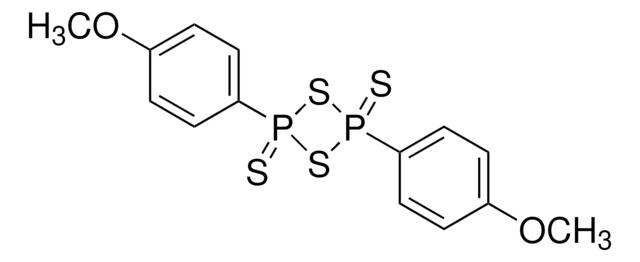All Photos(1)
About This Item
Linear Formula:
NH3
CAS Number:
Molecular Weight:
17.03
MDL number:
UNSPSC Code:
12352300
PubChem Substance ID:
NACRES:
NA.21
Recommended Products
form
liquid
concentration
0.30-0.50 M (by NaOH, titration)
0.4 M in THF
technique(s)
tissue culture: suitable (plant)
density
0.881 g/mL at 25 °C
storage temp.
2-8°C
SMILES string
N
InChI
1S/H3N/h1H3
InChI key
QGZKDVFQNNGYKY-UHFFFAOYSA-N
Looking for similar products? Visit Product Comparison Guide
Related Categories
Application
Ammonia solution was used in the detection of ammonia formed by the degradation of ammonium nitrate using quantum cascade laser (QCL) technology.
Use of ammonia as:
Studies of contributions of archaea and bacteria to the ammonia-oxidizing potential of soils
Interaction of ammonia and xenon with imidazole glycerol phosphate synthase from Thermotoga maritima
Metabolism of ammonia in Aedes aegypti fat body and midgut tissues
Used by ammonia-oxidizing bacteria
- A phermone in anuran tadpoles
- A nutrient in soil for plant nutrition
Studies of contributions of archaea and bacteria to the ammonia-oxidizing potential of soils
Interaction of ammonia and xenon with imidazole glycerol phosphate synthase from Thermotoga maritima
Metabolism of ammonia in Aedes aegypti fat body and midgut tissues
Used by ammonia-oxidizing bacteria
Signal Word
Danger
Hazard Statements
Precautionary Statements
Hazard Classifications
Acute Tox. 4 Oral - Carc. 2 - Eye Irrit. 2 - Flam. Liq. 2 - STOT SE 3
Target Organs
Central nervous system, Respiratory system
Supplementary Hazards
Storage Class Code
3 - Flammable liquids
WGK
WGK 1
Flash Point(F)
-7.6 °F
Flash Point(C)
-22 °C
Choose from one of the most recent versions:
Already Own This Product?
Find documentation for the products that you have recently purchased in the Document Library.
Customers Also Viewed
Takeshi Hozuki et al.
Microbes and environments, 25(2), 95-102 (2010-01-01)
Tetraheme cytochrome c-554 is a physiological electron acceptor of hydroxylamine oxidoreductase (HAO), a core enzyme of ammonia oxidation in chemoautotrophic nitrifiers. Here we report the purification of cytochrome c-554 from Nitrosococcus oceani strain NS58, a marine gammaproteobacterial ammonia-oxidizing bacterium. The
Y B Manteifel et al.
Physiological research, 60 Suppl 1, S185-S191 (2011-07-23)
In laboratory experiments, conspecific excretions and ammonia solutions evoked avoidance reactions in tadpoles of three anuran species, Bufo bufo, Rana temporaria, and Rana arvalis. A differential sensitivity of ammonia chemoreception was determined for two anuran species. For Bufo bufo tadpoles
Christoph Liebold et al.
Protein science : a publication of the Protein Society, 19(9), 1774-1782 (2010-07-29)
The imidazole glycerol phosphate (ImGP) synthase from the hyperthermophilic bacterium Thermotoga maritima is a 1:1 complex of the glutaminase subunit HisH and the cyclase subunit HisF. It has been proposed that ammonia generated by HisH is transported through a channel
Anne E Taylor et al.
Applied and environmental microbiology, 76(23), 7691-7698 (2010-10-05)
A method was developed to determine the contributions of ammonia-oxidizing archaea (AOA) and ammonia-oxidizing bacteria (AOB) to the nitrification potentials (NPs) of soils taken from forest, pasture, cropped, and fallowed (19 years) lands. Soil slurries were exposed to acetylene to
Patricia Y Scaraffia et al.
Journal of insect physiology, 56(9), 1040-1049 (2010-03-09)
In order to understand at the tissue level how Aedes aegypti copes with toxic ammonia concentrations that result from the rapid metabolism of blood meal proteins, we investigated the incorporation of (15)N from (15)NH(4)Cl into amino acids using an in
Our team of scientists has experience in all areas of research including Life Science, Material Science, Chemical Synthesis, Chromatography, Analytical and many others.
Contact Technical Service








